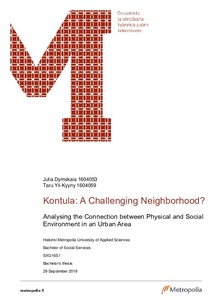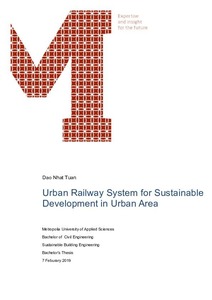Kontula - A Challenging Neighbourhood? : Analysing the Connection between Physical and Social Environment in an Urban Area
Dymskaia, Julia; Yli-Kyyny, Taru Juulia (2019)
Dymskaia, Julia
Yli-Kyyny, Taru Juulia
2019
All rights reserved. This publication is copyrighted. You may download, display and print it for Your own personal use. Commercial use is prohibited.
Julkaisun pysyvä osoite on
https://urn.fi/URN:NBN:fi:amk-2019102920354
https://urn.fi/URN:NBN:fi:amk-2019102920354
Tiivistelmä
The objective of this Bachelor's thesis was to explore Kontula – district of Helsinki city, Finland. More specifically, how residents experience their neighbourhood and whether they have place attachment to their living area. Another verge of the question was whether their socioeconomic background had an effect on their level of place attachment. Furthermore, we researched how urban spaces and their structure affected individuals’ possibilities to interact with each other and how the reputation of the area influences residents’ experiences as well as attitudes towards their neighbourhood.
The study was implemented by using qualitative research methods and contained two data collecting procedures, observing the area of Kontula and interviewing locals. Observations and interviews were carried out between spring and summer of 2019. Observations took place during different times and days and contained altogether 30 hours of exploring the area of Kontula. In total, the study contains nine interviews two of which were conducted in small groups of 2 to 3 individuals. After every interview, we applied a mapping technique, asking participants to mark their favourite and most dislikeable area of Kontula as well as how they perceive the borders of the area.
The results showed that the diversity of the interviewees had only little impact on their experiences of Kontula as a residential area. Nearly all the participants said that they considered the local shopping centre somewhat unpleasant. The study showed that younger interviewees had the strongest place attachment to Kontula as their own neighbourhood. Participants expressed that Kontula’s library and surrounding nature were the greatest qualities of the neighbourhood. Based on the study, the interaction between the residents of Kontula and sense of community seemed to remain mainly between next-door neighbours or people with similar socioeconomic status.
Participants perceived that Kontula’s reputation was distorted and exaggerated through media. The restlessness of the shopping centre area and the substance abusers were most commonly pointed out as Kontula’s dependent reason for the territorial stigma. Improving the shopping centre area was brought up as a way to revitalize the neighbourhood. Physical and social changes in the area were mostly seen positively by the participants.
The study was implemented by using qualitative research methods and contained two data collecting procedures, observing the area of Kontula and interviewing locals. Observations and interviews were carried out between spring and summer of 2019. Observations took place during different times and days and contained altogether 30 hours of exploring the area of Kontula. In total, the study contains nine interviews two of which were conducted in small groups of 2 to 3 individuals. After every interview, we applied a mapping technique, asking participants to mark their favourite and most dislikeable area of Kontula as well as how they perceive the borders of the area.
The results showed that the diversity of the interviewees had only little impact on their experiences of Kontula as a residential area. Nearly all the participants said that they considered the local shopping centre somewhat unpleasant. The study showed that younger interviewees had the strongest place attachment to Kontula as their own neighbourhood. Participants expressed that Kontula’s library and surrounding nature were the greatest qualities of the neighbourhood. Based on the study, the interaction between the residents of Kontula and sense of community seemed to remain mainly between next-door neighbours or people with similar socioeconomic status.
Participants perceived that Kontula’s reputation was distorted and exaggerated through media. The restlessness of the shopping centre area and the substance abusers were most commonly pointed out as Kontula’s dependent reason for the territorial stigma. Improving the shopping centre area was brought up as a way to revitalize the neighbourhood. Physical and social changes in the area were mostly seen positively by the participants.
Kokoelmat
Samankaltainen aineisto
Näytetään aineisto, joilla on samankaltaisia nimekkeitä, tekijöitä tai asiasanoja.
-
Urban Railway System for Sustainable Development in Urban Area
Nhat Tuan, Dao (Metropolia Ammattikorkeakoulu, 2019)The aim of this thesis was to study an urban railway system for sustainable development of a metropolitan area. The thesis studied a basic type of municipal railway and its implementation by, first, studying two well-developed ... -
Mapping Thermal Hotspots in Malé, Maldives : Assessing the Relationship Between Urban Heat Islands, Climate, and Heat Risk for Sustainable Urban Planning
Hameed, Aminath Maiha (2023)This study aims to support climate-conscious urban development in greater Male’, Maldives, based on characterizations of the local microclimate. It explores intra-urban temperature variations, identifies heat risks and ... -
Assessing the Influence of Urban Form on the Cooling Impacts of Urban Parks : A Case Study in Glasgow
Lelei, Najma Yusuf (2023)Urban Heat Island (UHI) effect has been a growing concern in the UK; therefore, the mitigation of such effects would contribute to sustainable urban development. A review of literature indicates that green infrastructure ...



